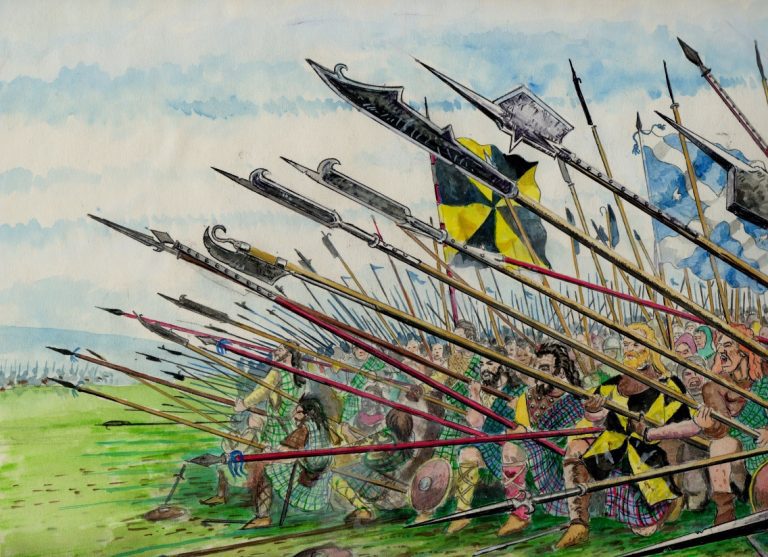Donald Stewart 2nd of Invernahyle, also known as Domhnull nan ord (Donald of the Hammers) b.1525 – d.1607, led the Appin men into battle near Musselburgh.
On the morning of Saturday, 10 September, Somerset advanced his army to close up with the detachment at Inveresk. He found that Arran had moved his army across the Esk by the ‘Roman bridge’, and was advancing rapidly to meet him. Arran knew himself to be outmatched in artillery and therefore tried to force close combat before the English artillery could deploy.
Battle of Pinkie, woodcut illustration from William Patten, (1548)
Arran’s left wing came under fire from English ships offshore. (Their advance meant that the guns on their former position could no longer protect them.) They were thrown into disorder and were pushed into Arran’s own division in the centre.
On the other flank, Somerset threw in his cavalry to delay the Scots’ advance. The Scottish pikemen drove them off and inflicted heavy casualties on the English horsemen. Lord Grey himself was wounded by a pike thrust through his throat and into his mouth.
The Scottish army was by now stalled and under heavy fire on three sides, from ships’ cannon, artillery, arquebusiers and archers, to which they had no reply. When they broke, the English cavalry rejoined the battle following a vanguard of 300 experienced soldiers under the command of Sir John Luttrell. Many of the retreating Scots were slaughtered or drowned as they tried to swim the fast-flowing Esk or cross the bogs.
The English eye-witness William Patten described the slaughter inflicted on the Scots,
Soon after this notable strewing of their footmen’s weapons, began a pitiful sight of the dead corpses lying dispersed abroad, some their legs off, some but houghed, and left lying half-dead, some thrust quite through the body, others the arms cut off, diverse their necks half asunder, many their heads cloven, of sundry the brains pasht out, some others again their heads quite off, with other many kinds of killing. After that and further in chase, all for the most part killed either in the head or in the neck, for our horsemen could not well reach the lower with their swords. And thus with blood and slaughter of the enemy, this chase was continued five miles in length westward from the place of their standing, which was in the fallow fields of Inveresk until Edinburgh Park and well nigh to the gates of the town itself and unto Leith, and in breadth nigh 4 miles, from the Firth sands up toward Dalkeith southward. In all which space, the dead bodies lay as thick as a man may note cattle grazing in a full replenished pasture. The river ran all red with blood, so that in the same chase were counted, as well by some of our men that somewhat diligently did mark it as by some of them taken prisoners, that very much did lament it, to have been slain about 14 thousand. In all this compass of ground what with weapons, arms, hands, legs, heads, blood and dead bodies, their flight might have been easily tracked to every of their three refuges. And for the smallness of our number and the shortness of the time (which was scant five hours, from one to well nigh six) the mortality was so great, as it was thought, the like aforetime not to have been seen



